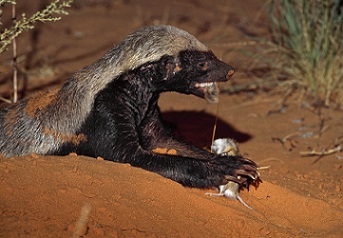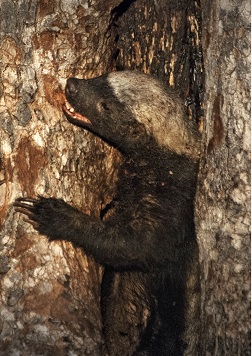What's On the Menu?
With the honey badger being the fearsome and effective
predator that it is, much can be said on the subject of its
diet. It is a carnivore, and has a unique and widely varied diet
As with most animals, the diet depends on a number of factors,
including temperature and rainfall. As one might assume, during
periods when life is thriving and abundant, the honey badger’s
diet will not be as diverse. This is because during the harsher
times, the honey badger will have to branch out and find
different and more diverse sources in order to eat the same
amount (Begg et al. 2003).
be as diverse. This is because during the harsher
times, the honey badger will have to branch out and find
different and more diverse sources in order to eat the same
amount (Begg et al. 2003).
What the honey badger eats depends on the sex of the animal in
question. It has been noted that honey badgers exhibit sexual
dimorphism not only in their physical size, but in their eating
habits as well (Begg et al. 2003). In general, male honey badgers
were observed to go for larger prey than their female counterparts
(Begg et al. 2003). Two main hypotheses have been proposed in an
attempt to explain this attribute of sexual dimorphism. The first
states that this sexual dimorphism occurs to reduce the overlap in
the diets of males and females. That is so that males do not have to
take food from females, and females aren’t competing with the larger
and stronger males for the same food (Begg et al. 2003). The other
hypothesis claims that females are smaller because they then require
less energy for life overall, letting them devote more energy to
reproduction and caring for their young.
 When honey badgers were studied in the Kalahari, they were
reported eating over sixty different species of prey (Begg et al.
2003)! Some of the more interesting species include highly venomous
snakes such as adders, cobras, and
black mambas. They were also seen
catching large reptiles such as leguaans and even a meter-long
crocodile (Begg 2012). As far as mammals go, honey badgers have been
seen hunting wild cats, jackals, and foxes, among other mammals
(Begg 2012). Not every animal the honey badger eats is a dangerous,
large animal however. A significant portion of the honey badger’s
diet is smaller animals including insects and larvae. In fact, the
honey badger will relentlessly hunt down bee hives in order to get
at the honey and more importantly the
honey bee larva inside (Begg 2012).
When honey badgers were studied in the Kalahari, they were
reported eating over sixty different species of prey (Begg et al.
2003)! Some of the more interesting species include highly venomous
snakes such as adders, cobras, and
black mambas. They were also seen
catching large reptiles such as leguaans and even a meter-long
crocodile (Begg 2012). As far as mammals go, honey badgers have been
seen hunting wild cats, jackals, and foxes, among other mammals
(Begg 2012). Not every animal the honey badger eats is a dangerous,
large animal however. A significant portion of the honey badger’s
diet is smaller animals including insects and larvae. In fact, the
honey badger will relentlessly hunt down bee hives in order to get
at the honey and more importantly the
honey bee larva inside (Begg 2012).
Nutrition plays a key role in the survival and development of the honey badger. To learn how their reproductive tendencies relates to this species' success, take a look at the Reproduction page!
